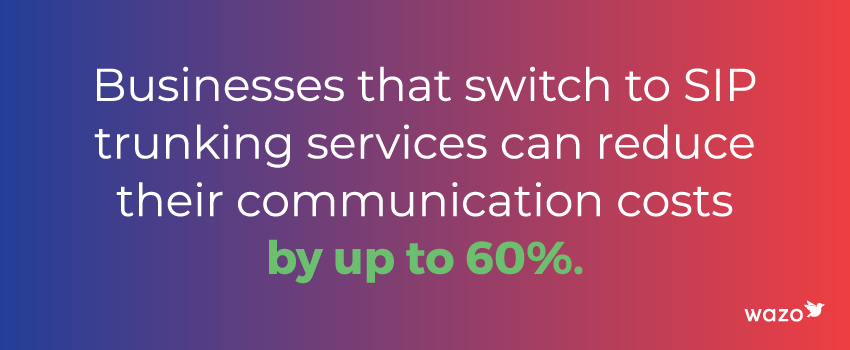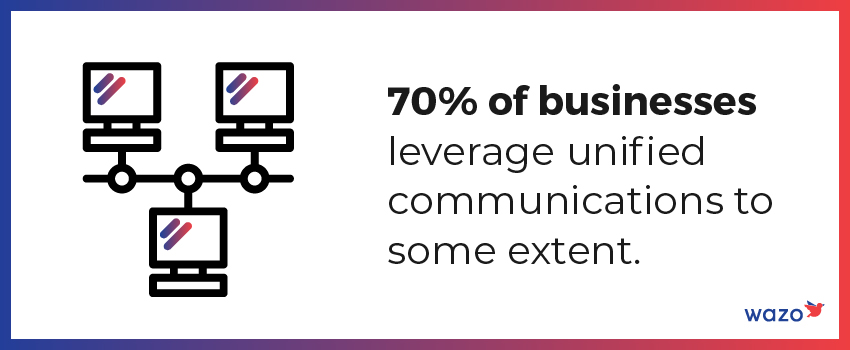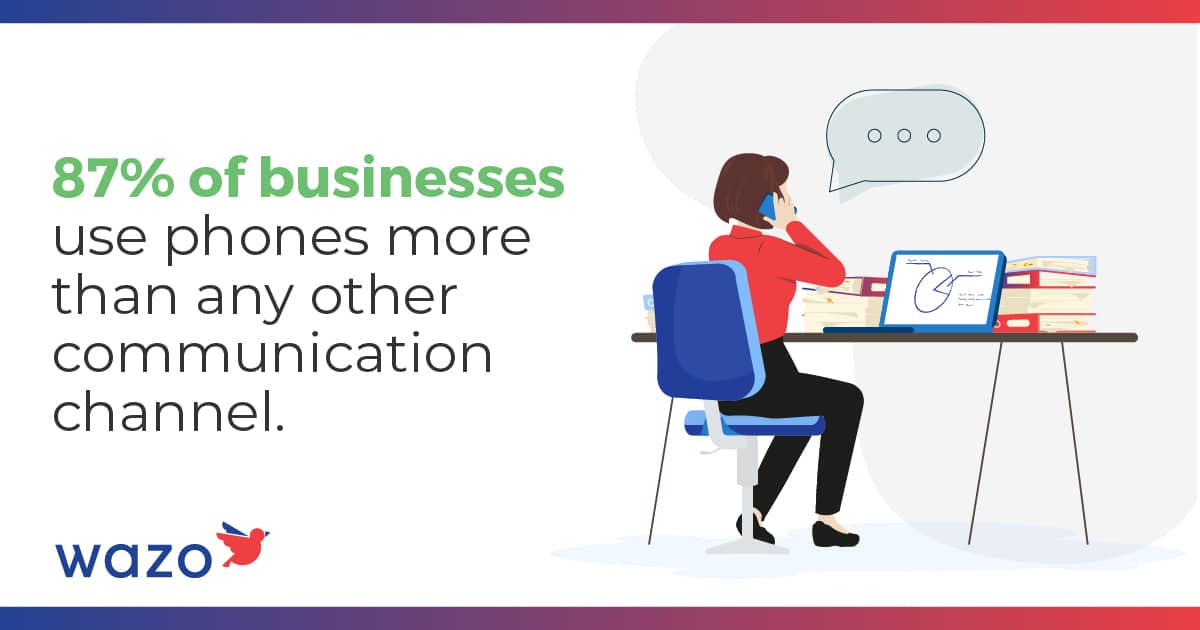When considering an enterprise phone system, many businesses are left deciding between a PRI or SIP (session initiation protocol) solution to connect to the outside world. While these two approaches both link businesses to the public switched telephone network (PSTN), they’re very different in terms of technology, cost, and capabilities.
Around 87% of companies use phone service more than any other communication channel.1 Clearly, voice calls are still the method of choice for business communications – so finding the best phone system for your business communication needs should be a top priority. In this blog, we’ll dive into the differences, pros and cons, and considerations for PRI and SIP systems to help you find the right fit.
What Is PRI?
Primary Rate Interface (PRI) uses a physical connection installed on an organization’s premises to establish voice communication with the public switched telephone network. Developed as an alternative to traditional POTS (plain old telephone service) – which can only handle one phone call at a time – PRI can transmit as many as 23 voice channels over a single line.
PRI Pros and Cons
Pros:
- Primary Rate Interface is installed on-premises, so it offers a higher level of security than hosted phone system solutions.
- Because PRI offers dedicated phone lines through a physical connection, users can avoid call quality issues associated with VoIP (voice over primary internet protocol) phones, such as jitter, latency, and packet loss.
- PRI doesn’t rely on data bandwidth for voice communications, enabling businesses to prioritize bandwidth for other critical applications.
Cons:
- Implementing Primary Rate Interface involves purchasing and installing specialized hardware in addition to ongoing maintenance costs.
- Unlike VoIP phone service, PRI often requires a contract with a traditional phone service provider for local and long-distance calling.
- Adding new phone lines requires modifying the existing PRI system infrastructure and can take weeks or months of waiting.
PRI Use Cases
Companies that need dedicated channels, consistent call quality, or compatibility with legacy systems can benefit from using PRI for their business communications. A few use cases for PRI systems include:
Critical Communication Needs
Industries like healthcare, emergency services, and public safety depend on reliable voice communication for critical operations. A PRI system can offer the uninterrupted communication these organizations need in emergencies.
Locations With Limited Connectivity
PRI systems can offer dependable voice communications for businesses in areas where the internet connection is limited or unreliable. Since PRI lines are dedicated physical connections, they aren’t subject to disruptions due to internet outages or fluctuations in network performance.
Legacy Phone Systems
Many large enterprises have already invested in on-premises private branch exchange (PBX) or legacy phone systems. PRI systems are compatible with traditional phone lines, allowing businesses to leverage their current infrastructure while transitioning to more modern communication solutions.

What Is SIP Trunking?
SIP trunking uses the session initiation protocol (SIP) to provide a virtual connection to the PSTN, allowing businesses to send and receive voice calls and other communications without requiring on-site infrastructure. It works by converting voice calls into data packets and transmitting them over an internet protocol (IP) network, allowing for unlimited voice channels and simultaneous calls.
SIP Trunking Pros and Cons
Pros:
- SIP trunking systems can integrate with unified communications (UC) platforms and support multimedia data transmissions, such as instant messaging and video calls.
- Since SIP trunking works with existing PBX system hardware, it doesn’t require high upfront installation costs.
- SIP trunking offers unlimited local and long-distance calling and services on a per-channel basis, so businesses save on communication costs significantly.
- SIP phones and their features are accessible on any device with an internet connection, enabling businesses to support mobile and remote workers.
- SIP systems don’t require additional physical hardware or wiring, so they’re easy to set up and scale as needed.
Cons:
- Quality of service (QoS) for SIP systems depends on available bandwidth, so businesses may have to upgrade their internet service.
- SIP systems operate over the internet, so securing them often requires adding additional security measures, such as firewalls.
- Transitioning to an internet-based phone system may carry a high learning curve for some employees.
SIP Trunking Use Cases
Because SIP trunking is such a versatile communication solution, businesses across many industries can benefit from making the switch. Some common use cases for SIP trunking include:
Multi-Site Organizations
Companies with multiple locations or branch offices use SIP trunking to streamline communication across their entire network. Instead of maintaining separate phone systems and interconnections between each location, SIP trunking allows for centralized management and more cost-effective communication between staff at different sites.
Reduced Communication Costs
Businesses that switch to SIP trunking services can reduce their total cost of ownership (TCO) by up to 60%.2 Since SIP trunks leverage IP infrastructure, they eliminate the need for separate voice and data networks. Plus, the lower long-distance and international call rates offered by SIP systems can add up to significant savings, especially for businesses that operate on a global scale.
Work-From-Anywhere Teams
Remote and hybrid workforces aren’t going anywhere, but many businesses struggle to support these flexible work models with traditional on-premise PBX systems. SIP trunking allows employees to connect to the business phone system using their mobile devices or softphone applications to collaborate and communicate, regardless of location.
PRI vs. SIP Trunking: A Comparison
While PRI and SIP trunking both connect businesses to the outside world, that’s where their similarities end. Here’s how these technologies stack up against each other:
Cost
SIP trunking systems are typically more cost-effective than PRI since SIP trunks reduce infrastructure and maintenance costs and offer lower long-distance and international rates, especially if your business makes a lot of calls in those categories.
PRI systems require wired phone lines, so they’re typically expensive to install and maintain compared to SIP trunks. Additionally, long-distance and international rates may be higher for PRI calls.
Scalability
SIP trunking makes scaling your communications easy since you can add or remove voice channels on demand.
PRI technology has a fixed number of channels per line, such as 23 channels for T1 PRI or 30 channels for E1 PRI. Expanding your capacity with PRI often requires additional physical lines.
Reliability
With the right network design and high-quality internet, SIP trunks can offer high reliability for business communications. Redundancy measures like backup connections and failover mechanisms can help to minimize downtime, and service level agreements (SLAs) can outline the uptime and response times you can expect from your provider.
A PRI line typically offers consistent call quality and lower susceptibility to issues related to internet connectivity. Plus, PRI systems can have built-in backup lines for added redundancy and failover capabilities.
Compatibility
SIP trunking is compatible with IP phones, including modern IP-PBX and VoIP systems, and it can integrate with a variety of third-party applications.
A PRI connection is compatible with legacy PBX systems, making a PRI line an attractive option if you prefer to maintain an existing phone infrastructure.
Flexibility
Since SIP trunks can integrate with unified communications platforms and support voice, video, messaging, and collaboration tools, you can provide employees and customers alike with seamless communication across different channels and devices.
PRI systems provide reliable voice communication, but they don’t offer the same level of integration and advanced features as SIP trunking solutions.
Security
SIP calls can be vulnerable to security threats, such as toll fraud or eavesdropping, but many security measures – including session border controllers (SBCs) and encryption protocols – can help to mitigate these risks.
Since PRI systems are based on physical circuits, they’re less susceptible to threats that target IP networks. PRI lines are isolated from internet-based attacks, but you still have to put physical security measures in place to protect against unauthorized physical access to your telephone network and lines.

Which Is Best for Your Business?
PRI and SIP trunking each offer distinct advantages and disadvantages, so choosing which is right for your business will ultimately depend on your unique communication needs.
With 70% of businesses currently leveraging unified communication solutions,3 a SIP trunk solution may be the way to go if your goal is to stay competitive. On the other hand, PRI could be the right choice if you need a communication platform that offers more compatibility with legacy systems.
For some companies, a hybrid approach that leverages both SIP and PRI works best. For example, if you run an educational facility, you might benefit from implementing UC via SIP trunking while maintaining some PRI connections to support legacy intercom technology.
If you’re trying to decide which option is right for your business, consider factors such as your existing infrastructure, preferred communication features, scalability needs, and budget as a starting point.
Modernize Your Communications With Wazo
As more businesses make the switch to UCaaS, moving to a flexible UC solution can help modernize your business with all the IP telephony features your teams need to stay productive and connected from anywhere.
Wazo makes it easy for businesses to transition to a complete unified communication solution in a single click. Our platform supports both SIP and PRI connections, so you can access a suite of enterprise IP phone system features that support the growth of your business – without having to make changes to your existing infrastructure. Contact Wazo today to learn more.
Sources:


